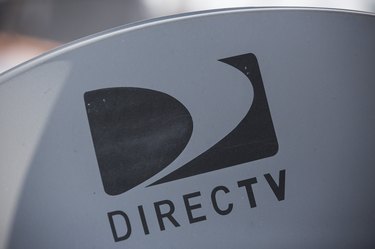
Since DirectTV doesn't uninstall old dishes, you might have to get creative when it comes to re-purposing or upcycling your old satellite. If local recycling isn't an option, maybe you can whip up some sort of makeshift parabolic spy microphone with an old tin can? Or, if you're feeling a little less crazy, you can just use the old dish to grab a few extra HD channels. Grab a ladder, get a buddy to spot you and let's get dishing.
How It Works
Video of the Day
Even when your DirectTV subscription lapses, your dish still has some utility. The large, concave shape of the dish itself "catches" over-the-air signals and funnels those signals into the feed horn, the pole-shaped portion of the dish that faces inward.
Video of the Day
So, will a satellite dish work as an antenna by itself? No, but it can work in tandem with a simple outdoor antenna to produce potentially impressive results.
What you'll essentially be doing here is using the bowl-shaped DirectTV dish to amplify the signal for an external antenna to catch. According to Interesting Engineering, some do-it-yourselfers have increased the amount of free TV channels they receive from about three to more than 40 using this method.
Let's Go Antenna Shopping
To convert your old satellite dish to an HDTV antenna, you'll need a specific type of antenna. What you're looking for is an HD antenna with a coaxial connection (the old-school screw-in type of connector that you use for cable TV and cable internet). This type of antenna receives free, over-the-air (OTA) broadcasts in high-def. The number of OTA HD channels you receive depends on your area, but using your dish to grab more signal can greatly increase the antenna's range.
Now that you know what type of antenna you need, look for an outdoor model that is compact enough to mount on the feed horn of your DirectTV dish. Ideally, you'll want an antenna that uses a U-bolt for installation so it can be easily secured to a pole. As of 2018, you should be able to swing this for $50 or less.
Your Antenna-Sat TV Setup
Here's where a little elbow grease comes in. Use the antenna's included U-bolt to secure the antenna to the dish's feed horn. If the antenna is too big and you're the handy type, you can use a bit of pipe to extend the feed horn. In any case, the most important thing here is that the antenna is secured to the feed horn and that it faces inward, toward the dish. Once secured, direct your dish toward the local TV broadcast towers, which are likely located in the nearest metropolitan area.
When your DirectTV dish was installed, the installer ran a coaxial cable from the dish to the house – that's what you'll be using to connect your new antenna. Screw the coaxial cable on the dish into the antenna's coax port, then screw the end of the cable that's in your home into the coax port on the back of your HDTV and you're ready to channel surf.
- Interesting Engineering: 4 Brilliant Ways You Can Re-Purpose a Satellite Dish
- Pokapu Akoranga Putaiao Science Learning Hub: How a Satellite Dish Works
- Crutchfield: Choosing the Best HDTV Antenna
- New York Magazine: The Best Outdoor TV Antennas on Amazon, According to Hyperenthusiastic Reviewers
- Tablo: Tablo FAQs – Can I Use Satellite Dish Equipment as an OTA Antenna?
- Tablo: Position Matters: Choosing Where to Place Your HDTV Antenna – OTA HDTV Blog 4
- Apartment Therapy: How to Reuse a Digital Satellite Dish for Free Over-the-Air TV Channels
- Earth911: Need to Recycle Your Satellite TV Dish? Read This First